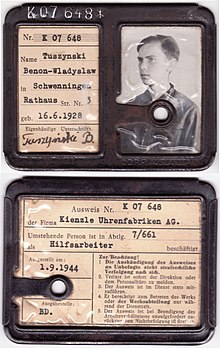Kienzle watches
| Kienzle International AG
|
|
|---|---|
| legal form | GmbH |
| founding | 1822 |
| resolution | 2014 |
| Reason for dissolution | insolvency |
| Seat | Hamburg , Germany |
| management | Dirk Weiss |
| Website | www.kienzle1822.com |
Kienzle Uhren was a German watch manufacturer until 2014, most recently with its headquarters in Hamburg .
history
Kienzle was founded in Schwenningen am Neckar in 1822 as a German watch factory by master watchmaker Johannes Schlenker . At the beginning, Schlenker sold hand-made Black Forest clocks as a peddler . Under his grandson Carl Johannes Schlenker and his brother-in-law Jakob Kienzle , who married in 1883 , a series production of alarm clocks and regulating mechanisms was started under the signature Schlenker & Kienzle. The 20,000 wall clocks and pendulum clocks produced annually were made exclusively by hand. In 1893, 162,000 clocks and alarm clocks were already being produced each year.
From 1894, with the help of industrialized production, prefabricated, standardized individual parts and openwork plates were used, among other things to reduce the amount of material used and thus the costs of alarm clocks and wall clocks. This process optimization in production was innovative at the time.
From 1897 Jakob Kienzle became the sole owner, and after some time the name of the company was changed into the current form Kienzle. Watch production was expanded and modernized, and international activities expanded. In the following years, in addition to a factory in Bohemia , branches in Milan, Paris and London were established.
Around the year 1899 around 400 employees produced a million clocks and alarm clocks each year.
In 1900 the company brought the time clock onto the market, followed by inexpensive pocket watches, travel alarm clocks and wristwatches for women and the first on-board clocks for automobiles.
After the First World War, the German watch industry went through a permanent crisis. The consequences of the war, inflation and foreign competition threatened German suppliers. From 1926 onwards, the large watch manufacturers were negotiating cooperations and mergers, as a result of which the Kienzle watch factories merged with Thomas Ernst Haller AG Schwenningen to form Kienzle-Haller AG. Talks with Friedrich Mauthe GmbH, also based in Schwenningen, were broken off. During this time, the Kienzle Taximeter und Apparate AG (later Kienzle Apparate ) split off from the Kienzle watch factories and continued the entire range of instruments and control apparatus for factories and vehicles (especially taximeters and work display watches) under its own responsibility.
In 1931 Kienzle brought the hard-wearing wristwatch onto the market. Due to its construction, this watch was very resilient and well over 25 million copies were sold. At the end of the 1930s, the company began manufacturing two types of table clocks in the upper price category: the zodiac clock and the world clock . From 1936 onwards, the products were presented throughout Germany in specially converted buses. As a further development of the car clock, the 8-day pilot's watch was created in the 1930s , which was built into the dashboard of the aircraft cockpit.
In 1939, Kienzle had over 3,500 employees who manufactured 5 million watches a year. The company's history continued immediately after the Second World War. From 1956 the so-called Volksautomatik was used for production. A rotor that wound in both directions of rotation supplied the mechanism with energy. The anchor was designed as a pin-stone lever escapement, patented by Kienzle lever escapement.
In the 1960s and 1970s, the company developed into the market leader in Germany. In 1963 the first solar watch ("Heliomat"), in 1972 the first battery-powered watch and the first quartz movement were produced. In the following years, Kienzle was the first company to produce a quartz LED wristwatch and presented the first quartz-powered travel alarm clock.
The solar clock developed in 1986 with its lower light requirement and polycrystalline solar generator was also a novelty. At the beginning of the 1990s, the company developed a watch that was waterproof to a depth of 12,000 meters and presented the world's first radio alarm clock with an analog alarm time setting.
In 1996, the company launched a new radio-controlled clockwork. The small two-motor installation, which was controlled by radio, set itself faster than other plants and was therefore a world first.
present
In 1997, Kienzle was taken over by the Highway Holdings group. In 2002 the company returned to Germany with the establishment of Kienzle AG. Since then, the company's headquarters have been in Hamburg. Among other things, the company bought the trademark rights and began developing and manufacturing three new watch collections in different price categories. In 2008, the company moved its headquarters to an old Hamburg merchant's house in Hamburg-Harvestehude.
In early 2010, Kienzle had to file for bankruptcy again, which was followed by restructuring. The worldwide trademark rights have been owned by Premier Trademarks AG in Switzerland since 2011. An attempt to restart ended in 2014 in another bankruptcy. However, watches are still sold under the name Kienzle.
See also
literature
- Hans-Heinrich Schmid : Lexicon of the German watch industry 1850–1980: company addresses, production program, company logos, brand names, company histories . (3rd expanded edition 2017) Publisher: German Society for Chronometry 2017; ISBN 978-3-941539-92-1
- Jan Lehmhaus, Tim Stefan Schmidt and Peter Welchering: Kienzle . Volume 1. Füssli, Zurich, 2008. ISBN 978-3-280-05331-7
- Armin Müller: Kienzle. A German industrial company in the 20th century , 2nd edition, Franz Steiner Verlag: Stuttgart 2014, ISBN 978-3-515-10669-6
Web links
Individual evidence
- ↑ a b wristwatches. Heel, Königswinter 2009. ISSN 1431-3677 . Page 55
- ^ Lehmhaus, Schmidt, Welchering, pages 11fff.
- ^ Lehmhaus, Schmidt, Welchering, page 12
- ↑ Kienzle clocks. March 7, 2017, accessed on January 7, 2020 (German).
- ^ Lehmhaus, Schmidt, Welchering, page 14
- ^ Lehmhaus, Schmidt, Welchering, page 16
- ^ Lehmhaus, Schmidt, Welchering, page 19
- ↑ a b c Lehmhaus, Schmidt, Welchering, page 35
- ^ Lehmhaus, Schmidt, Welchering, page 36
- ^ Lehmhaus, Schmidt, Welchering, page 37
- ^ Lehmhaus, Schmidt, Welchering, page 35ff
- ↑ Contribution 1997: Takeover of the company by the Highway Holdings group, Hong Kong. ( Memento of the original from July 19, 2012 in the Internet Archive ) Info: The archive link was inserted automatically and has not yet been checked. Please check the original and archive link according to the instructions and then remove this notice.
- ↑ Chronos Edition: Watches 2008 . Ebner, Ulm 2007, ISBN 978-3-87188-089-6 and ISBN 978-3-87188-091-9 , p. 84.
- ↑ a b A secret man in the watch industry. Retrieved November 2, 2018 .
- ↑ Kienzle: Off for Hamburg watch brand . In: Watchtime.net . January 22, 2010 ( watchtime.net [accessed November 2, 2018]).
- ↑ Watch manufacturer Kienzle files for bankruptcy. In: trustedwatch.de. Retrieved January 8, 2016 .
- ↑ Kienzle watches for men and history . In: Herrenuhren24.net . ( herrenuhren24.net [accessed November 2, 2018]).
- ↑ KIENZLE watches | The oldest German watch brand. Accessed January 7, 2020 (German).










